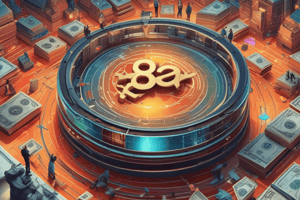Podcast
Questions and Answers
What is a key action to optimize working capital?
What is a key action to optimize working capital?
- Eliminate all cash reserves
- Increase cash expenditures on unnecessary items
- Negotiate better payment terms with suppliers (correct)
- Minimize cash flow analysis
Which strategy is NOT recommended to mitigate liquidity risk?
Which strategy is NOT recommended to mitigate liquidity risk?
- Diversify revenue streams
- Set aside a portion of profits as an emergency fund
- Avoid securing credit lines (correct)
- Maintain a stable cash reserve
What is one consequence of poor liquidity management?
What is one consequence of poor liquidity management?
- Higher cash reserves
- Increased operational efficiency
- Reduced ability to cover unexpected expenses (correct)
- Improved credit ratings
Which approach helps in securing adequate collateral for recovery rate risk?
Which approach helps in securing adequate collateral for recovery rate risk?
Which of the following is an example of unsystematic risk?
Which of the following is an example of unsystematic risk?
What is a recommended method to mitigate exposure rate risk?
What is a recommended method to mitigate exposure rate risk?
What does geographical diversification aim to achieve?
What does geographical diversification aim to achieve?
Which of the following strategies addresses credit event risk?
Which of the following strategies addresses credit event risk?
What is the definition of systematic risk in finance?
What is the definition of systematic risk in finance?
Which of the following best describes interest rate risk?
Which of the following best describes interest rate risk?
What is a common strategy to mitigate interest rate risk?
What is a common strategy to mitigate interest rate risk?
Which of the following is NOT a component of interest rate risk?
Which of the following is NOT a component of interest rate risk?
What kind of risk is considered uncontrollable by individual organizations?
What kind of risk is considered uncontrollable by individual organizations?
Investors can hedge against interest rate risk by using which of the following?
Investors can hedge against interest rate risk by using which of the following?
What is market risk?
What is market risk?
Which of these strategies would NOT help in mitigating interest rate risk?
Which of these strategies would NOT help in mitigating interest rate risk?
What is the impact of systematic risk on financial decision-making?
What is the impact of systematic risk on financial decision-making?
Which type of risk is concerned with price fluctuations of a specific asset?
Which type of risk is concerned with price fluctuations of a specific asset?
What is the primary purpose of diversification in risk management?
What is the primary purpose of diversification in risk management?
How does hedging help in risk management?
How does hedging help in risk management?
What does a stop-loss order do?
What does a stop-loss order do?
What is the function of Value at Risk (VaR) in risk management?
What is the function of Value at Risk (VaR) in risk management?
Which of the following describes basis risk?
Which of the following describes basis risk?
What is a key component of stress testing in risk management?
What is a key component of stress testing in risk management?
What does liquidity management primarily focus on?
What does liquidity management primarily focus on?
Which option describes purchasing power risk?
Which option describes purchasing power risk?
How can an investor mitigate purchasing power risk?
How can an investor mitigate purchasing power risk?
What is systematic risk primarily concerned with?
What is systematic risk primarily concerned with?
What defines unsystematic risk?
What defines unsystematic risk?
Which of the following contributes to liquidity risk?
Which of the following contributes to liquidity risk?
What type of securities can help protect against inflation?
What type of securities can help protect against inflation?
What is a characteristic of funding liquidity risk?
What is a characteristic of funding liquidity risk?
Flashcards
Risk in Finance
Risk in Finance
The possibility of a negative financial outcome.
Systematic Risk
Systematic Risk
Risks affecting the entire market or economy. They are beyond the control of individual businesses.
Interest Rate Risk
Interest Rate Risk
The chance that rising interest rates will decrease the value of fixed-income investments.
Price Risk
Price Risk
Signup and view all the flashcards
Reinvestment Rate Risk
Reinvestment Rate Risk
Signup and view all the flashcards
Diversification
Diversification
Signup and view all the flashcards
Hedging
Hedging
Signup and view all the flashcards
Derivatives
Derivatives
Signup and view all the flashcards
Purchasing Power/Inflationary Risk
Purchasing Power/Inflationary Risk
Signup and view all the flashcards
Demand Inflation Risk
Demand Inflation Risk
Signup and view all the flashcards
Cost Inflation Risk
Cost Inflation Risk
Signup and view all the flashcards
Business/Liquidity Risk
Business/Liquidity Risk
Signup and view all the flashcards
Asset Liquidity Risk
Asset Liquidity Risk
Signup and view all the flashcards
Funding Liquidity Risk
Funding Liquidity Risk
Signup and view all the flashcards
Liquidity Management
Liquidity Management
Signup and view all the flashcards
Market Risk
Market Risk
Signup and view all the flashcards
Absolute Risk
Absolute Risk
Signup and view all the flashcards
Relative Risk
Relative Risk
Signup and view all the flashcards
Directional Risk
Directional Risk
Signup and view all the flashcards
Non-Directional Risk
Non-Directional Risk
Signup and view all the flashcards
Basis Risk
Basis Risk
Signup and view all the flashcards
Volatility Risk
Volatility Risk
Signup and view all the flashcards
Financial / Credit Risk
Financial / Credit Risk
Signup and view all the flashcards
Exposure Rate Risk
Exposure Rate Risk
Signup and view all the flashcards
Recovery Rate Risk
Recovery Rate Risk
Signup and view all the flashcards
Credit Event Risk
Credit Event Risk
Signup and view all the flashcards
Sovereign Risk
Sovereign Risk
Signup and view all the flashcards
Settlement Risk
Settlement Risk
Signup and view all the flashcards
Operational Risk
Operational Risk
Signup and view all the flashcards
Model Risk
Model Risk
Signup and view all the flashcards
Study Notes
Systemic Risk
-
Interest Rate Risk: Possibility that changes in interest rates reduce the value of fixed-rate investments or debt securities.
-
Price Risk: Bond prices fluctuate with interest rates.
-
Reinvestment Rate Risk: Uncertainty about returns when interest rates change.
HOW TO MITIGATE INTEREST RATE RISK? 1. Diversification A bondholder concerned about interest rate risk can mitigate it by diversifying their portfolio with less interest-sensitive securities, like equities, or by incorporating a mix of short-term and long-term bonds. 2. Hedging Interest rate risk can be mitigated using various hedging strategies, including derivatives. ● Market Risk: The possibility of losses from factors affecting the overall financial markets. ○ Absolute Risk: The total risk of an investment ○ Relative Risk: Investment risk compared to a benchmark ○ Directional Risk: Risk associated with rising/falling market trends ○ Non-Directional Risk: Risk associated with market volatility ○ Basis Risk: Difference between related assets changing unexpectedly ○ Volatility Risk: Risk of significant price fluctuations HOW TO MITIGATE MARKET RISK? 1. Diversification Diversify investments across asset classes to minimize market volatility. Include geographic diversification to mitigate region-specific risks. 2. Hedging Use derivatives to hedge against adverse price movements. Example: Currency futures to lock in exchange rates, or options to cap losses in stock prices. 3. Asset Allocation Maintain a balanced portfolio tailored to risk tolerance and market conditions. Adjust allocations periodically based on market analysis and personal/organizational goals. 4. Stop-Loss Orders Set automatic orders to sell an asset if its price falls below a predetermined level to limit potential losses. 5. Risk Management Policies Establish internal guidelines and limits for risk exposure, ensuring adherence to sound financial practices. Use Value at Risk (VaR) models to quantify potential losses and guide decisions. 6. Stress Testing and Scenario Analysis Conduct simulations of extreme market conditions to evaluate portfolio vulnerabilities and develop contingency plans. 7. Monitoring and Analysis Regularly monitor market trends, news, and economic indicators. 8. Liquidity Management Maintain sufficient liquid assets to meet obligations without selling investments at a loss during volatile periods. 9. Utilizing Technology Leverage risk management software and tools to track exposures, model risks, and optimize portfolio decisions. ● Purchasing Power/Inflationary Risk: The risk that the value of money decreases over time due to inflation. ○ Demand Inflation Risk: Increased prices due to higher demand ○ Cost Inflation Risk: Increased prices due to production costs rising HOW TO MITIGATE PURCHASING POWER RISK? 1. Incorporate Inflation Premiums: ○ Build an inflation premium into the interest rate or required rate of return (RoR). 2. Adjust for Unanticipated Inflation: ○ Simply adding an inflation premium cannot address unexpected inflation changes. 3. Use Inflation-Protected Securities: ○ Treasury Inflation-Protected Securities (TIPS): Adjust coupon and principal payments based on the Consumer Price Index (CPI). Provide a guaranteed real return aligned with actual inflation rates. 4. Consider Variable-Rate Securities: ○ Provide protection as cash flows (interest, dividends) are linked to indices (e.g.. prime rate) influenced by inflation. 5. Leverage Convertible Bonds: ○ Offer dual benefits by sometimes trading like bonds and other times like stocks. Correlation with stock prices provides partial inflation protection. Unsystematic Risk ● Business/Liquidity Risk: Inability to meet short-term financial obligations. ○ Asset Liquidity Risk: Difficulty selling assets without significant price change ○ Funding Liquidity Risk: Inability to secure necessary funding, HOW TO MITIGATE LIQUIDITY RISK? 1. Implement Cash Management Strategic ○ Regular Cash Flow Analysis - monitor cash inflows and outflows regularly Cash Forecasting - forecast future cash needs based on operational and seasonal needs Optimize Working Capital - negotiate better payment terms 2. Maintain a Stable Cash Reserve Emergency Fund Allocation - Set aside a portion of profits as a liquidity buffer to cover unexpected expenses or downturns. Access to Credit Lines - Secure standby credit facilities or overdraft agreements to address short-term cash shortfalls. 3. Diversify Revenue Streams ○ Expand Product/Service Offerings - Introduce new products or services that generate additional revenue streams. Geographical Diversification - Target multiple markets to reduce dependency on a single region Customer Base Diversification - Avoid overreliance on a single customer or segment for revenue. ● Financial/Credit Risk: Possibility of a borrower defaulting on financial obligations. ○ Exposure Rate Risk: Risk related to the level of financial exposure ○ Recovery Rate Risk: Risk of recovering less than expected from defaults ○ Credit Event Risk: Risk of unexpected credit-related events ○ Sovereign Risk: Risk associated with government debt defaults ○ Settlement Risk: Risk of transaction settlement failures HOW TO MITIGATE CREDIT RISK? 1. For Exposure Rate Risk ○ Diversify Credit Exposure Set Exposure Limit 2. For Recovery Rate Risk ○ Secure Adequate Collateral Strengthen Recovery Processes 3. For Credit Event Risk ○ Monitor Credit Ratings Use Credit Derivatives 4. For Sovereign Risk ○ Assess Country Risk ○ Diversify Geographic Exposure 5. For Settlement Risk ○ Use DVP Systems Partner with Trusted Counterparties ● Operational Risk: Potential losses due to internal process, system, or external events failures ○ Model Risk: Errors in financial models leading to flawed decisions ○ People Risk: Losses caused by human error/fraud ○ Legal Risk: Costs/losses due to legal actions, regulatory breaches ○ Political Risk: Losses from political instability
-
Studying That Suits You
Use AI to generate personalized quizzes and flashcards to suit your learning preferences.




